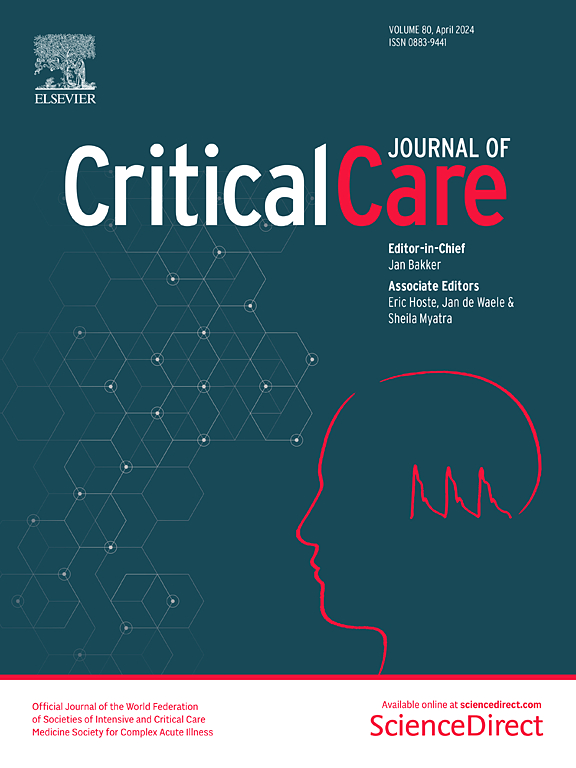Complementary role of transcriptomic endotyping and protein-based biomarkers for risk stratification in sepsis-associated acute kidney injury
IF 8.8
1区 医学
Q1 CRITICAL CARE MEDICINE
引用次数: 0
Abstract
Sepsis-associated acute kidney injury (SA-AKI) is a prevalent and severe complication in critically ill patients. However, diagnostic and therapeutic advancements have been hindered by the biological heterogeneity underlying the disease. Both transcriptomic endotyping and biomarker profiling have been proposed individually to identify molecular subtypes of sepsis and may enhance risk stratification. This study aimed to evaluate the utility of combining transcriptomic endotyping with protein-based biomarkers for improving risk stratification in SA-AKI. This secondary analysis of the PredARRT-Sep-Trial included 167 critically ill patients who met Sepsis-3 criteria. Patients were stratified into three transcriptomic endotypes—inflammopathic (IE), adaptive (AE), and coagulopathic (CE)—using a validated whole-blood gene expression classifier. Eight protein-based biomarkers encompassing kidney function, vascular integrity, and immune response were measured. Predictive performance for the primary endpoint kidney replacement therapy or death was assessed using receiver operating characteristic curve analysis and logistic regression models. Stratification into transcriptomic endotypes assigned 33% of patients to IE, 42% to AE, and 24% to CE. Patients classified as IE exhibited the highest disease severity and were most likely to meet the primary endpoint (30%), compared to AE and CE (17% and 10%, respectively). Kidney function biomarkers showed stepwise increases with AKI severity across all endotypes, whereas non-functional biomarkers (neutrophil gelatinase-associated lipocalin [NGAL], soluble urokinase plasminogen activator receptor [suPAR], and bioactive adrenomedullin [bio-ADM]) exhibited endotype-specific differences independent of AKI severity. NGAL and suPAR levels were disproportionately elevated in the IE group, suggesting a dominant role of innate immune dysregulation in this endotype. In contrast, bio-ADM, a marker of endothelial dysfunction, was the strongest risk-predictor of outcomes in CE. The combination of transcriptomic endotyping with protein-based biomarkers enhanced predictive accuracy for the primary endpoint and 7-day mortality, with the highest area under the receiver operating characteristic curve of 0.80 (95% CI 0.72–0.88) for endotyping + bio-ADM and 0.85 (95% CI 0.78–0.93) for endotyping and suPAR, respectively. Combinations of endotyping with functional and non-functional biomarkers particularly improved mortality-related risk stratification. Combining transcriptomic endotyping with protein-based biomarker profiling enhances risk-stratification in SA-AKI, offering a promising strategy for personalized treatment and trial enrichment in the future. Further research should validate these findings and explore therapeutic applications.转录组内分型和基于蛋白质的生物标志物在脓毒症相关急性肾损伤风险分层中的补充作用
脓毒症相关急性肾损伤(SA-AKI)是危重症患者普遍存在的严重并发症。然而,该疾病的生物学异质性阻碍了诊断和治疗的进展。转录组内分型和生物标志物分析都被单独提出用于鉴定脓毒症的分子亚型,并可能增强风险分层。本研究旨在评估结合转录组内分型和基于蛋白质的生物标志物对改善SA-AKI风险分层的效用。这项对PredARRT-Sep-Trial的二级分析纳入了167名符合脓毒症-3标准的危重患者。使用经过验证的全血基因表达分类器,将患者分为三种转录组内型——炎性(IE)、适应性(AE)和凝血功能障碍(CE)。测量了八种基于蛋白质的生物标志物,包括肾功能、血管完整性和免疫反应。使用受试者工作特征曲线分析和logistic回归模型评估主要终点肾脏替代治疗或死亡的预测性能。按转录组内分型分层,33%的患者为IE, 42%为AE, 24%为CE。与AE和CE(分别为17%和10%)相比,IE患者表现出最高的疾病严重程度,并且最有可能达到主要终点(30%)。肾功能生物标志物在所有内源性类型中均随AKI严重程度逐步增加,而非功能性生物标志物(中性粒细胞明胶酶相关脂钙蛋白[NGAL]、可溶性尿激酶纤溶酶原激活剂受体[suPAR]和生物活性肾上腺髓质素[bio-ADM])则表现出与AKI严重程度无关的内源性特异性差异。在IE组中,NGAL和suPAR水平不成比例地升高,表明先天免疫失调在这种内型中起主导作用。相比之下,内皮功能障碍标志物bio-ADM是CE预后的最强风险预测因子。转录组内分型与基于蛋白质的生物标志物的结合提高了主要终点和7天死亡率的预测准确性,内分型+生物adm和suPAR的受试者工作特征曲线下的最高面积分别为0.80 (95% CI 0.72-0.88)和0.85 (95% CI 0.78-0.93)。内皮分型与功能性和非功能性生物标志物的结合尤其改善了死亡率相关的风险分层。结合转录组内分型和基于蛋白质的生物标志物分析增强了SA-AKI的风险分层,为未来的个性化治疗和试验丰富提供了有前途的策略。进一步的研究应该验证这些发现并探索治疗应用。
本文章由计算机程序翻译,如有差异,请以英文原文为准。
求助全文
约1分钟内获得全文
求助全文
来源期刊

Critical Care
医学-危重病医学
CiteScore
20.60
自引率
3.30%
发文量
348
审稿时长
1.5 months
期刊介绍:
Critical Care is an esteemed international medical journal that undergoes a rigorous peer-review process to maintain its high quality standards. Its primary objective is to enhance the healthcare services offered to critically ill patients. To achieve this, the journal focuses on gathering, exchanging, disseminating, and endorsing evidence-based information that is highly relevant to intensivists. By doing so, Critical Care seeks to provide a thorough and inclusive examination of the intensive care field.
 求助内容:
求助内容: 应助结果提醒方式:
应助结果提醒方式:


